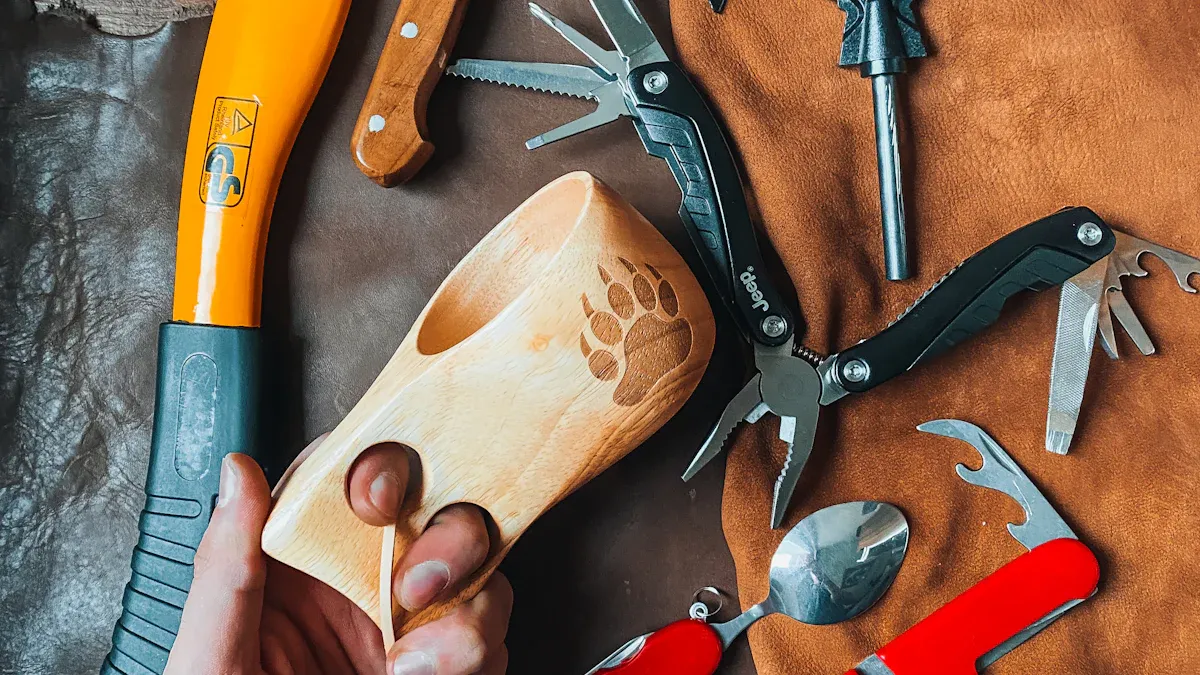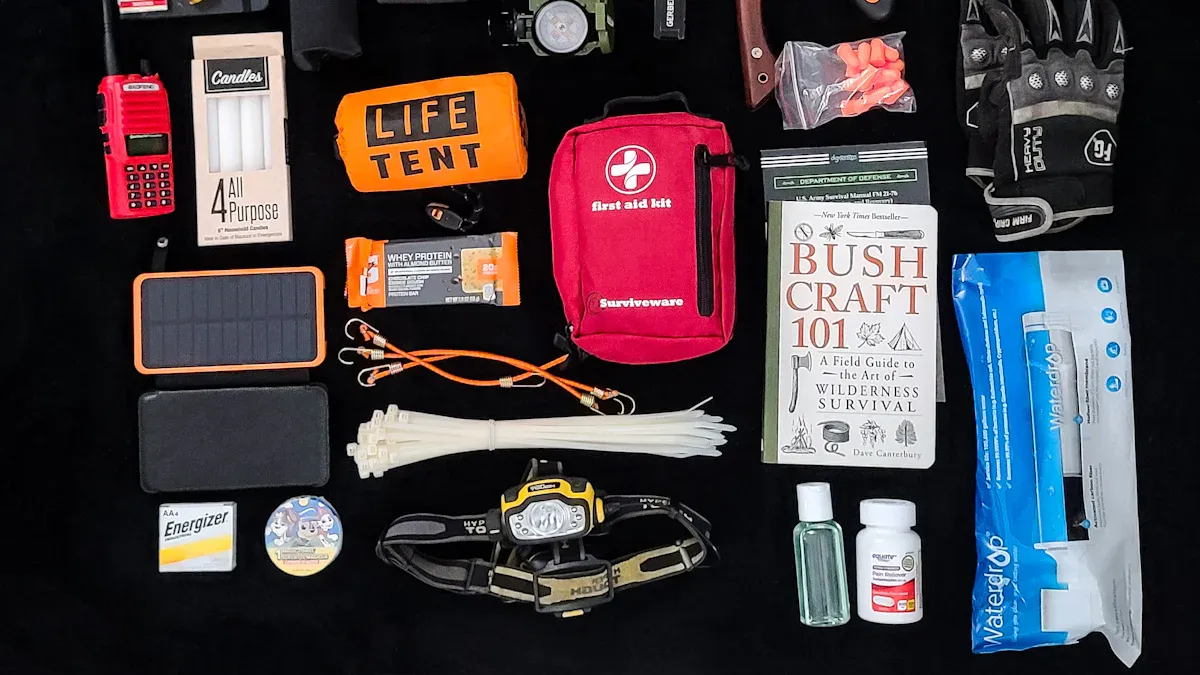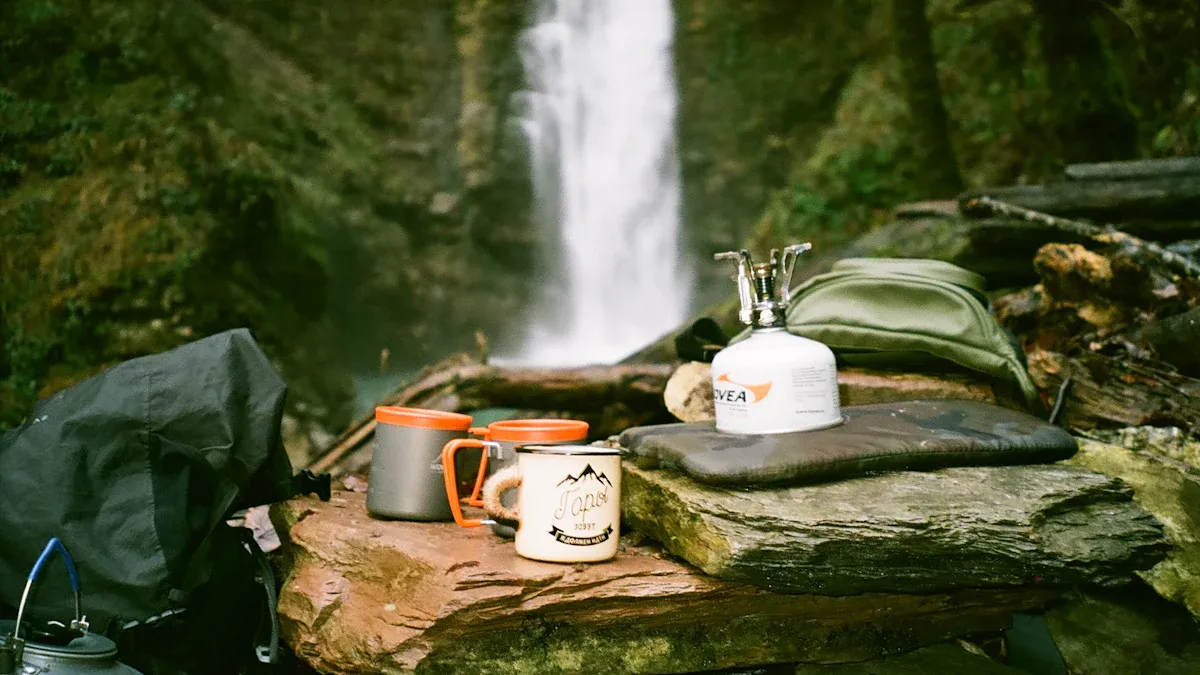10 Essential Items for Your Everyday Outdoor Kit

When you go hiking or exploring, being ready with your Everyday Outdoor Kit is key. Your outdoor kit is not just handy—it can save lives. The 10 must-haves, like a tool or flashlight, keep you prepared. These items in your Everyday Outdoor Kit help you stay safe and have fun outside.
Key Takeaways
A multi-tool is very important for outdoor trips. It helps fix things and handle tasks, keeping you ready for surprises.
Always bring a first-aid kit. It helps you treat wounds fast, keeping you safe and calm during your adventures.
Drink enough water with a good water bottle. Staying hydrated gives you energy and helps you stay alert while outdoors.
Multi-Tool for Everyday Outdoor Kit
Why a multi-tool is essential for outdoor activities
When you're out in the backcountry, a multi-tool can be your best friend. It’s like carrying a toolbox in your pocket. Whether you’re fixing broken gear, cutting through tangled layers of rope, or opening a can of food, a multi-tool has you covered. Outdoor adventures often throw unexpected challenges your way, and having the right tool on hand can make all the difference.
Imagine this: you’re hiking deep into the backcountry, and your backpack strap snaps. Without a multi-tool, you’d be stuck improvising. But with one, you can quickly repair your gear and keep moving. It’s not just about convenience—it’s about being prepared for anything.
Features to consider when choosing a multi-tool
Not all multi-tools are created equal. When picking one, think about the activities you enjoy most. If you’re into camping, look for tools like a knife, scissors, and a can opener. For backcountry hikes, pliers and screwdrivers might come in handy for fixing gear.
Weight matters too. You don’t want to carry something bulky, especially when you’re already managing layers of clothing and other essentials. Compact and lightweight options are ideal. Durability is another key factor. Stainless steel tools last longer and can handle tough tasks.
Finally, consider ease of use. A multi-tool with foldable parts that lock into place is safer and more efficient. The right multi-tool isn’t just a piece of gear—it’s a lifesaver in the wild.
First-Aid Kit for Emergencies
Why a first-aid kit is important outdoors
Nature can be unpredictable, and accidents can happen anytime. A first-aid kit is one of the most useful things to bring. It helps treat small injuries like cuts, scrapes, or blisters. For example, if you trip on a rock and scrape your knee, a first-aid kit can help. Cleaning and covering wounds quickly stops infections and helps them heal faster. This is especially important when you’re far from medical help.
Emergencies don’t wait for the right time. Whether you’re hiking for a day or camping for a week, a first-aid kit keeps you ready. It’s not just about being prepared—it helps you stay safe and enjoy your trip without stress.
What to pack in a first-aid kit
A good first-aid kit doesn’t need to be heavy. Start with basics like bandages, antiseptic wipes, and gauze pads. These are great for treating small injuries. Add tweezers for splinters or ticks, and pack pain medicine like ibuprofen.
For outdoor trips, look for kits made for wilderness use. Lightweight and waterproof kits, like the Adventure Medical Kits Ultralight/Watertight .5 or HART Outdoor Day Hike First-Aid Kit, are great choices.
Tip: Adjust your kit for your activities. If hiking in buggy areas, pack bug bite relief. For longer trips, add extra items like medical tape and scissors. Being ready can make your outdoor adventures safer and more fun.
Staying Hydrated with a Water Bottle or Hydration System

Why staying hydrated is important outdoors
When exploring, drinking water is very important. It keeps you energized and helps you focus. Without enough water, you might feel weak or dizzy. This can ruin your outdoor fun and even be unsafe. Your body needs water to stay cool and keep muscles working. Always carry a good water source with you.
Water affects how well you perform and stay safe. Experts say checking weight, urine color, and thirst helps track hydration. Here's a simple table to explain:
Hydration Check | How to Measure | When to Use |
|---|---|---|
Body Weight Change | Use a scale | During outdoor events or training |
Urine Color Test | Use a refractometer | To check hydration while being active |
Thirst Level Rating | Use a chart or scale | To know how thirsty you are in different settings |
Picking the best hydration system for you
Choosing the right way to carry water is important. You can use a water bottle or a hydration pack. For short trips, a bottle works fine. For longer trips, a hydration pack with a water filter is better. It lets you refill from streams or lakes safely.
Think about what feels easy to use. A hydration pack frees your hands and holds more water. Some packs even have snack pockets for extra energy. Pick what suits your activity, and you'll stay hydrated and ready for adventure.
Flashlight or Headlamp for Safety
Why lighting is important for outdoor safety
When outside at night, having light is very helpful. A flashlight or headlamp helps you see and stay safe. Imagine walking back to camp after dark. Without light, you might trip, lose the trail, or meet animals by surprise.
Light is also useful in emergencies. If you’re lost, a flashlight can signal for help. It helps rescuers find you from far away. Light isn’t just handy—it keeps you safe and visible.
Here’s why a good flashlight or headlamp is important:
Long battery life keeps it working on long trips.
Lightweight designs make them easy to carry or wear.
Many people pick rechargeable lights that are waterproof and tough. These are great for outdoor adventures.
Tips for choosing a good flashlight or headlamp
Choosing the right light doesn’t have to be hard. Think about what you need it for. Is it for short hikes or long camping trips?
Here’s a simple guide to help you pick:
Criteria | What to Look For |
|---|---|
Battery Life | Long-lasting batteries, especially for cold weather use. |
Water Resistance | Check if it can handle rain or splashes (IPX rating). |
Cold Weather Use | Pick lights that work well in freezing temperatures. |
Brightness | Higher lumens give better light in dark or foggy areas. |
Durability | Strong designs last longer and handle rough use. |
For nighttime activities, headlamps are great. They free your hands and give steady light. For emergencies, flashlights with strobe modes can signal for help. Choose one that works well for your needs and is dependable.
Fire Starter for Emergency Situations
The role of fire starters in wilderness survival kits
A fire starter is one of the most important tools you can carry in your outdoor kit. In a survival situation, fire provides warmth, cooks food, and even boosts morale. It can also act as a signal for help if you’re lost. Imagine being stuck in the wilderness on a cold night. Without fire, staying warm and safe becomes much harder.
Fire starters are essential for any wilderness survival kit because they make starting a fire quick and reliable. Matches or lighters can fail in wet or windy conditions, but a good fire starter works even in tough environments. It’s not just about convenience—it’s about survival.
Types of fire starters and how to choose the best one
There are several types of fire starters, and each has its strengths. Ferrocerium rods, or ferro rods, are popular because they create sparks even when wet. Magnesium blocks are another great option. They produce a hot flame that ignites easily. Waterproof matches and stormproof lighters are also handy for quick use.
When choosing a fire starter, think about your needs. Do you often hike in wet areas? Go for a waterproof option. Want something lightweight? Ferro rods are compact and easy to carry. Always test your fire starter before heading out. Knowing how to use it can save precious time in an emergency.
Tip: Pack some dry tinder, like cotton balls or dryer lint, to make starting a fire even easier.
Navigation Tools for Outdoor Adventures

Why maps, compasses, and GPS devices are important
When exploring, navigation tools help you avoid getting lost. They guide you and make your trip safer. A map, compass, or GPS can turn a tough trip into an easy one.
Here’s why these tools matter:
Maps work even if your phone dies or has no signal. They don’t need batteries or internet to help you.
A compass shows direction when you can’t see landmarks. It’s very useful in unknown areas.
GPS devices give real-time directions and updates. But don’t rely only on them.
These tools keep you safe and make planning routes easier. They also let you enjoy your trip without worrying about losing your way.
Picking and using navigation tools the right way
Choose tools based on your trip. For short hikes, a map and compass are enough. For longer trips, use a GPS with tracking and emergency alerts. Some GPS devices let you share your location, which is helpful.
Practice using these tools before your trip. Learn to read maps and use a compass. If using a GPS, know how to set waypoints and track routes. Always carry a backup map in case your GPS stops working.
Tip: Plan your route before you go. Mark key spots on your map or GPS. This helps you stay on track and enjoy your adventure without stress.
Emergency Blanket for Protection
Why an emergency blanket is important outdoors
An emergency blanket can save your life outside. It protects you from bad weather and sudden temperature changes. If it gets very cold, this blanket keeps you warm by reflecting your body heat. It’s small but very helpful in tough situations.
Emergency blankets are not just for cold days. They also help in hot weather by blocking the sun. You can use one as shade or wrap it around to avoid sunburn. If it rains or gets windy, it works as a quick shelter too.
These blankets are super useful. Use them as ground covers, rain catchers, or even to signal for help with their shiny surface. Keeping one in your kit means you’re ready for anything nature throws at you.
Lightweight and easy-to-carry emergency blankets
Emergency blankets are small and simple to carry. They weigh only a few ounces, so they won’t make your bag heavy. Mylar blankets are a favorite choice. They are light, strong, and keep you warm well.
Here’s why emergency blankets work so well:
Feature | What It Does | How It Helps in Cold Weather |
|---|---|---|
Keeps Heat In | Holds your body heat to keep you warm. | Very important for staying warm. |
Multi-Use | Works for many things, not just warmth. | Mylar blankets are light and useful. |
Light Weight | Easy to carry without adding much weight. | Doesn’t make your kit heavy. |
Pick blankets that are waterproof and don’t tear easily. These last longer and work better in tough weather. Having a good emergency blanket in your kit keeps you safe and ready for any outdoor trip.
Pocket Knife for Versatility
Why a pocket knife is important in your outdoor kit
A pocket knife is a handy tool for outdoor trips. It’s small, light, and useful in many ways. You can use it to cut rope, open packages, or prepare food. For example, if you need to tie your tent with paracord, a knife makes it easy.
This tool is not just for convenience—it helps you stay ready. In emergencies, a knife can make tools, start a fire, or protect you. Its small size means it fits in your gear without taking up space. Having a good knife gives you confidence to handle outdoor challenges.
Tip: Keep your knife sharp and clean. A sharp blade works better and lasts longer.
What to look for in a strong pocket knife
Not all pocket knives are the same. Pick one that is strong and useful. A good knife should have a sharp blade made of stainless steel. This keeps it from rusting and helps it last longer.
Choose a knife with a grip that feels good in your hand. This is important, especially in wet or cold weather. Folding knives with locks are safe and simple to use.
Here are key features to check:
Blade Material: Stainless steel stays sharp and resists rust.
Size and Weight: Small enough to carry but big enough to use.
Extra Tools: Some knives have screwdrivers or bottle openers for more uses.
A strong knife is a smart choice for safety and ease. Pick carefully, and it will be a key part of your outdoor kit.
Snacks or Energy Bars for Sustenance
Importance of high-energy food in outdoor activities
When you're out exploring, your body works harder than usual. It burns calories quickly, especially during activities like hiking or climbing. High-energy food is essential to keep you fueled and focused. Snacks or energy bars are perfect for this because they’re compact, easy to carry, and packed with the nutrition you need.
Did you know that 81% of protein bars are classified as "high in protein"? This means they contain more than 20% of their energy from protein, which helps repair muscles and keeps you feeling full. Whether you're on a short hike or a multi-day trek, having extra food ensures you won’t run out of energy when you need it most.
Suggestions for lightweight and nutritious snacks
Choosing the right snacks for your outdoor kit is simple. Look for options that are lightweight, nutritious, and easy to pack. Here are some great ideas:
Energy Bars: These are a classic choice. They’re small but packed with calories, protein, and healthy fats.
Trail Mix: A mix of nuts, seeds, and dried fruits provides a balance of carbs, protein, and fats. Plus, it’s easy to snack on while moving.
Jerky: High in protein and low in weight, jerky is a great option for longer trips.
Nut Butter Packets: These are portable and provide a quick energy boost. Pair them with crackers or eat them straight from the packet.
When picking snacks, check the labels for nutritional value. Aim for items with a good balance of protein, carbs, and fats. Having a variety of snacks keeps your energy levels steady and makes your outdoor adventure more enjoyable.
Tip: Always pack a little extra food. You never know when you might need it!
Paracord or Rope for Wilderness Survival Kits
Why paracord is useful outdoors
Paracord is a super handy tool for outdoor trips. It’s light, strong, and can be used in many ways. You can use it to build shelters, tie gear, or even fish.
Here are some ways to use paracord:
Fishing: Take out the inner strands to make a fishing line.
Hunting: Set up traps or snares to catch small animals.
Fire starting: Some paracords have a fire-starting line for wet weather.
Securing gear: Use it to tie down your tent or backpack.
Making slings: Create slings for carrying items or medical needs.
Fixing gear: Use the strands to sew or repair clothes and equipment.
Shelter building: Tie branches together to make a strong shelter.
Some paracords come with extras like fishing lines or fire-starting strands. These features make them even more useful for survival.
How to pick the best paracord
Not all paracords are the same. Picking a good one is important for outdoor safety. Choose paracord that is strong, light, and weatherproof.
Here’s a simple guide to help you choose:
Feature | What It Does |
|---|---|
Waterproof Tinder Line | Lets you start fires even when it’s wet. |
40-lb Test Polyethylene Line | Strong enough for fishing or heavy tasks. |
Absorbent Cotton Line | Great for sewing or fixing gear. |
Nylon Strands | Seven strands make it strong and useful for many tasks. |
Mold, Mildew, and Rot Resistant | Keeps the paracord lasting longer in tough outdoor conditions. |
Test the paracord before using it. It should be strong and easy to handle. Compact paracords are better since they save space in your kit. With the right paracord, you’ll be ready for any outdoor challenge.
Tip: Always pack extra paracord. It’s great for unexpected needs!
Bringing the 10 essentials in your outdoor kit is very important. These tools help you stay safe and handle surprises from nature.
Tip: Adjust your kit for your plans. Going hiking? Pack more snacks. Camping overnight? Bring a good flashlight.
Be ready, and every trip will be an adventure to remember. 🌟
FAQ
What should I do if I forget an essential item?
Stay calm and improvise. Use what you have to solve the problem. For example, a scarf can double as a bandage or sling.
How often should I check my outdoor kit?
Check it before every trip. Ensure all items are functional and restock anything you’ve used. Regular checks keep your kit reliable and ready.
Can I customize my outdoor kit?
Absolutely! Tailor your kit to your activities. For example, add sunscreen for sunny hikes or extra snacks for longer adventures. Personalizing it makes it more effective.
Tip: Always test new gear at home before heading outdoors. It ensures you know how to use it when needed!
See Also
Why Hunting Flashlights Are Crucial For Outdoor Adventures
Must-Have Hunting Gear Every Dad Should Own
SF1 Camping Flashlight: Brighten Your Outdoor Experiences
